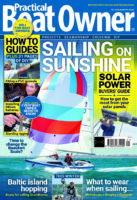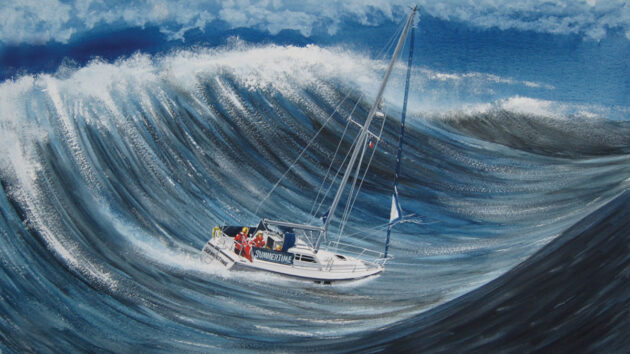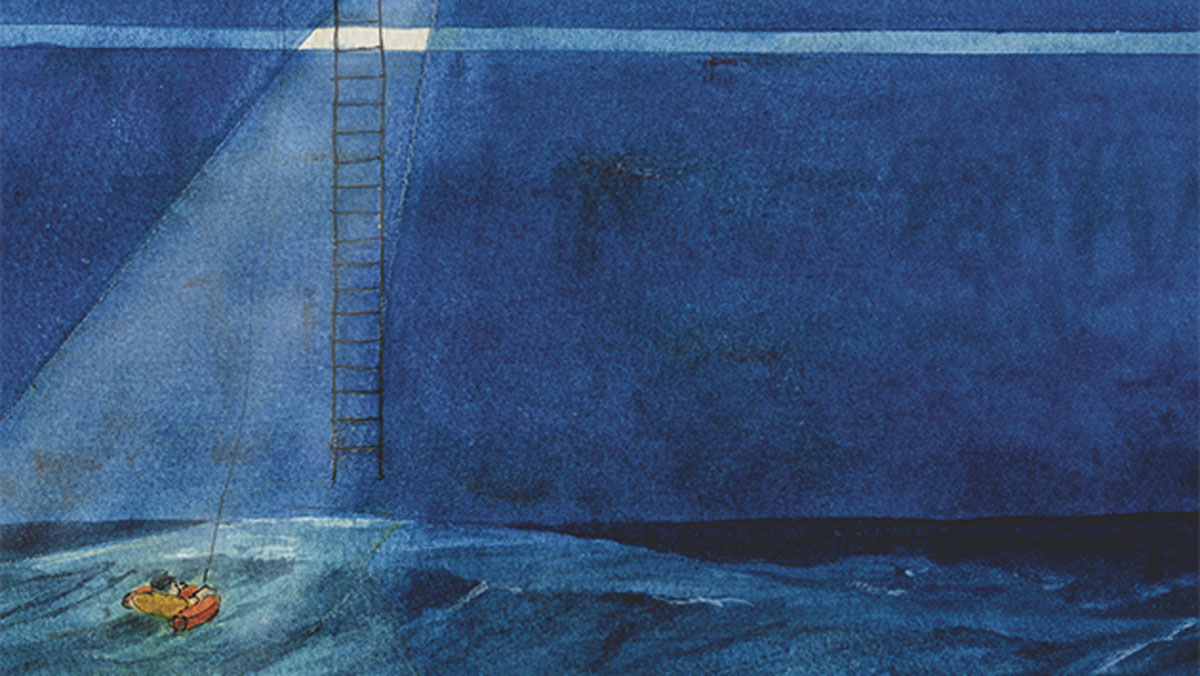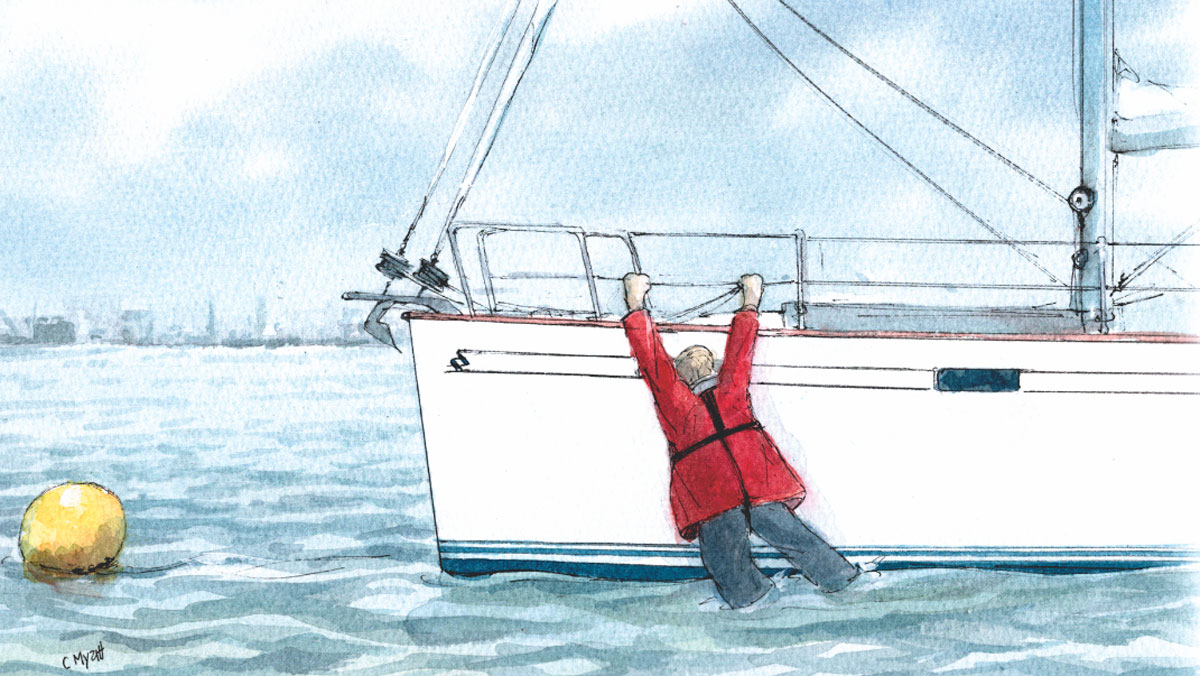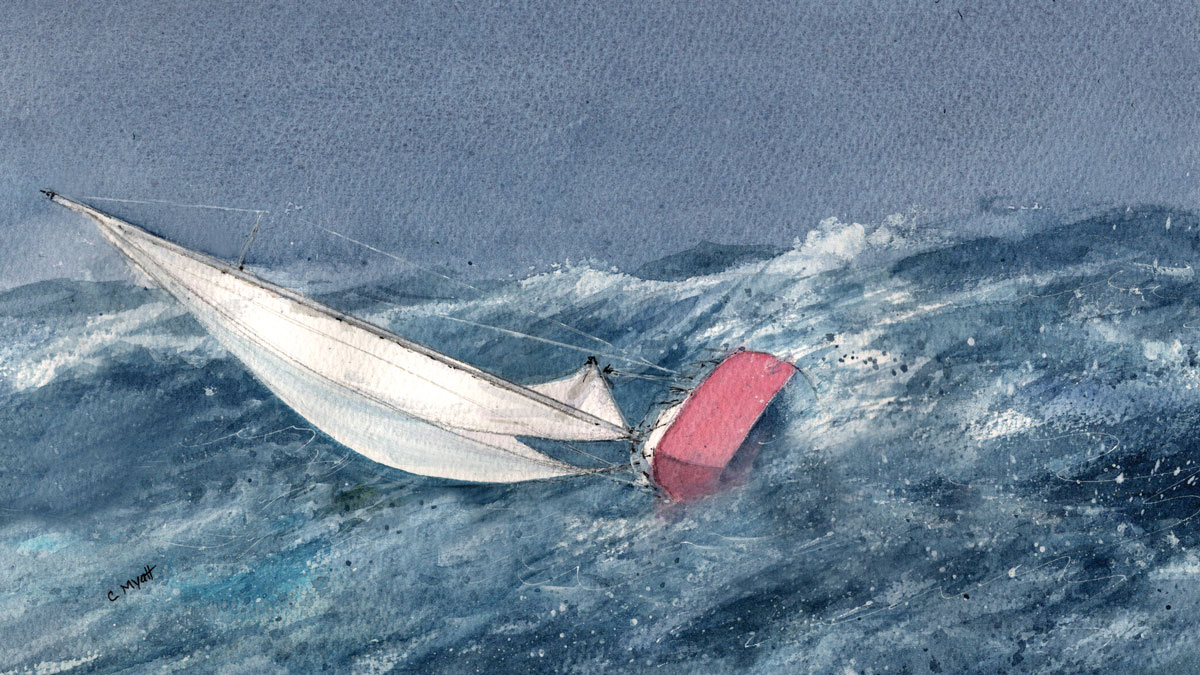A routine Channel crossing became a nerve-shredding passage when a ferocious storm hit, as Ron Stride recalls
This is an account of an unforgettable sail home to Chichester from St Vaast aboard Summertime, a 10m (33ft) Southerly 100, writes Ron Stride.
On board were Summertime’s owner and skipper, 72-year-old Ian Stride; myself, Ian’s 69-year-old brother; and Ian’s friend and neighbour Martin Kotchie, 68.
Tides are important when planning a Channel crossing. By exiting St Vaast as soon as the gates opened we’d face a strong incoming tidal flow for hours, but we decided that an early start would be better than waiting for a favourable tide – a decision also supported by favourable weather predictions.
It was a dull, cool June morning. The sea was fair but, as expected, a significant tide headed us on our course north.
A light south-easterly kept the sails full but gave insufficient drive. Meanwhile, our trusty Yanmar motor gave us reasonable over-ground progress at about four knots.
By the time the tide diminished the wind was still light, so we motored all morning.
At about 1400, we approached the TSS (Traffic Separation Scheme). Visibility was fair, but we had the radar on because there was a lot of large shipping in the area.
Wallowing around in a sloppy sea, we discussed whether the multi-purpose sail would steady the boat and allow us to make better progress.
Ian remarked that if we didn’t use it, this was going to be ‘the longest day’. He had no idea!
‘Storm Force 10, imminent’
With 45 miles still to run, we noticed to the south-west a light band of cloud at sea level, then a large, virtually black band, with more light sky above.
We couldn’t determine if this represented any kind of threat – but we soon found out. The sea suddenly started rising along with an increase in the wind from the south-west, so we started furling the sails.
Martin went below to get a weather update from the Solent coastguard, just in time to hear an alarming forecast for our sector: ‘Storm Force 9-10, imminent’.
At almost the same instant, a sudden gust knocked us onto our side to nearly 45°. The storm was already upon us.
The wind and sea built rapidly. Although the main was furled without too much drama, furling the jib became extremely difficult.
Large pieces of the UV strip were torn off and carried away on the wind.
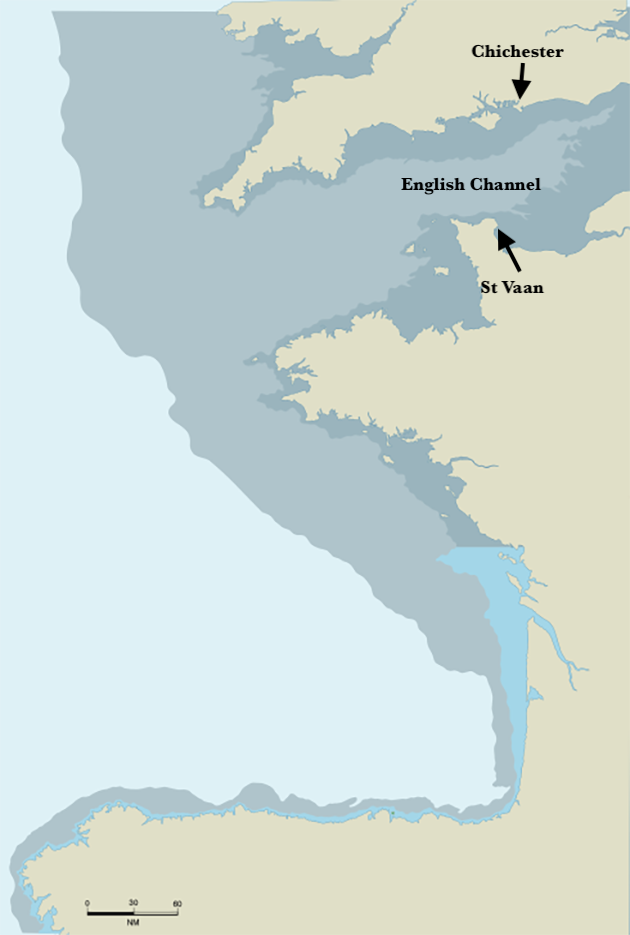
The pressure required to furl caused more than the usual number of turns and there was not enough line on the drum, so about 30cm of jib could not be furled.
The rest of it was packed like a neatly rolled umbrella, so maybe this small amount of jib could act as a steadying sail?
No way: shortly afterwards, the leech was torn by the wind.
Summertime took a colossal wave broadside, and the cockpit was suddenly knee-deep in water.
Ian shouted reassurances that it would drain, but if we took many more broadsides like these, we’d be done for.
The waves had built to almost 9m. Violent mast whipping meant we couldn’t rely on the wind gauge, but it looked like it was gusting between 50-60 knots.
Occasionally, a huge rogue wave would hit the boat. We tried surfing down the back of the waves, but the speed and angle of the bow pointing so far down was forcing it to submarine.
The rudder then came out of the water, and both steering and control were lost.
After another major swamp, Ian restored some control with the engine under power.
The wind happened to be in a favourable direction for our course home, and as the waves built, Ian reached the boat up the side of a wave and then down the other.
This procedure only failed if a real monster crashed over us.
When that happened we were swamped, but luckily not tipped out.
In time, Ian got into a kind of routine and began steadying the boat as much as conditions allowed.
We’d just had time to put on our foul-weather gear and lifejackets, so the next thing was to find the life harnesses and attach ourselves.
Martin and I retrieved a lanyard and clipped Ian to the steering position. Martin wedged himself in the companionway where he could monitor the radar, operate the chartplotter and listen to the radio. I clung onto Martin’s position and relayed messages to Ian, as the noise of the storm made it impossible for him to hear any of the electronic equipment.
Summertime was well designed for the conditions.
The cockpit, protected by a large sprayhood, is deep with high sides, while the fences are covered with spray-dodgers.
The canvas work may have helped to prevent the boat from a complete swamping and the crew being washed overboard.
The companionway has a fairly high step and there was one washboard, which we put in place.
This allowed about 70cm depth of water in the cockpit without flooding the cabin.
Another washboard to raise the companionway height would have helped.
About an hour into the storm, a pigeon landed clumsily on the deck and tried sheltering in front of the sprayhood.
After about an hour it took off again, but soon crashed-landed once more into the cockpit sole.
Martin and I fed it on some wet bread, but couldn’t eat properly ourselves as we needed both hands to hold on.
Visibility was very poor, and we were now smack in the centre of the busy shipping lanes.
We’d catch sight of the nearer ships when we popped up on top of the waves, and they’d then be out of sight while we were back down in the troughs.
On one of the knockdowns, the engine alarm sounded, possibly triggered by low oil pressure because the wave impact had sent all the oil to one side, away from the pump.
Or perhaps overheating was being caused by the water intake being tilted out of the water for too long.
We were hugely relieved when the alarm stopped, and glad it only sounded once!
After many hours we were heartened to see the Isle of Wight and hoped that some protection might be available, but the wind and waves were just as intense and, if anything, less predictable because of the land, currents and depths.
It was now dark, and the Solent shipping channel was a confusion of lights.
Finding the light of the Nab Tower took a long time, but once we saw it we felt a little more confident about reaching the safety of the harbour.

Ron Stride is a member of Sandringham YC, Melbourne, where he sailed an old H28 for 25 years. He has also cruised Farr yachts to the Whitsundays and Fife gaffers to Sydney
Getting from Chichester Bar into the harbour by Hayling Island was far from easy with wind over 4 knots of tide against us, but Ian was in home waters now.
He’d been on the wheel non-stop for more than eight hours, and now that he was in calm waters was keen to get to the marina, about an hour from the Chichester Bar, without delay.
Overwhelmed with relief, we four exhausted veterans (including the pigeon) arrived at the marina lock at about 0300 to find it open for us and the friendly lock-keeper ready to take our lines.
‘Must have been a bit rough out there,’ he said with a grin. What an understatement!
Our passage from St Vaast had been planned to cover about 80 miles and take less than 14 hours. It actually covered about 94 miles, and took 181⁄2 hours.
The pigeon flew off later in the morning. I wonder if it was French and had really intended to traverse La Manche to England?
If it had, it had been lucky to select such a solid boat as Summertime.
Lessons Learned
- Fully brief crew on all safety equipment. Ensure flares are accessible, and have a flash lamp plugged in and torches to hand.
- Have washboards ready to fit to the companionway to stop cockpit flooding finding its way below.
- Make sure plenty of line is on the furling drum of the foresail system.
- Harnesses and lifejackets with lights should be worn even in the calmest conditions.
- Prepare tidal data for the destination beyond the expected ETA.
- Keep chocolate or energy bars to hand.
Left for dead after falling overboard: how one sailor survived 5 hours lost at sea before rescue
Roger Cottle was presumed dead after falling overboard a 27ft yacht and lost at sea for five-and-a-half hours in a…
‘In a flash, I was hanging on the lifelines on the wrong side of the boat’
Solo sailor Tony Purcell discovered how quickly a tricky situation can develop when he fell overboard his 42ft yacht on…
What I learned during a boat knockdown while sailing alone
Freya Terry gets an early lesson in the perils of single-handed sailing when she embarks on a round-UK and Ireland…
Snap, shackle and drop: coping with a dismasted sailing yacht
Steve Hodges and his fiancée Sam McClements’ second attempt at the RYA Yachtmaster Ocean passage is scuppered by a dismasted…
Want to read more articles like Force 10 in the Channel aboard a 33ft yacht?
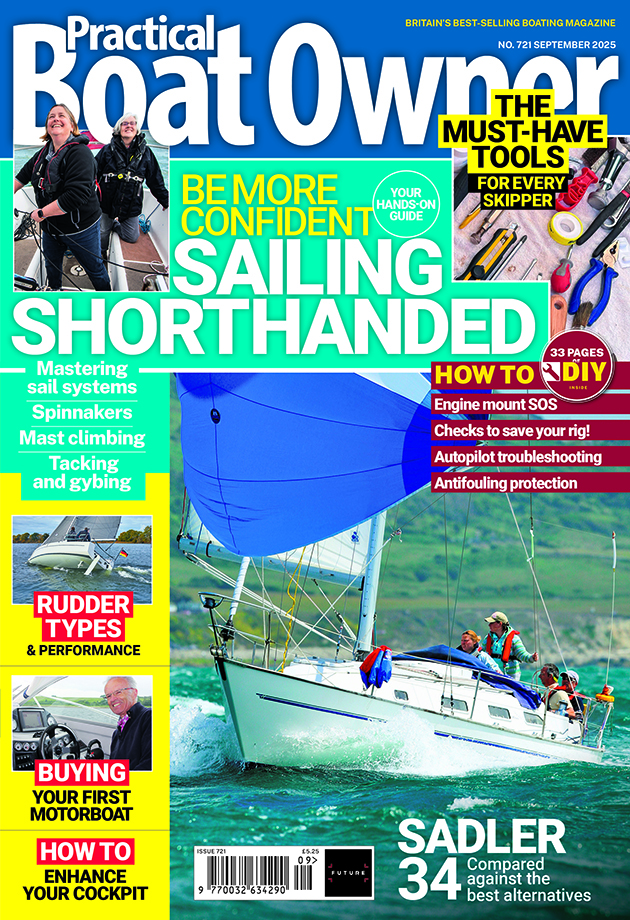
A subscription to Practical Boat Owner magazine costs around 40% less than the cover price.
Print and digital editions are available through Magazines Direct – where you can also find the latest deals.
PBO is packed with information to help you get the most from boat ownership – whether sail or power.
-
-
-
- Take your DIY skills to the next level with trusted advice on boat maintenance and repairs
- Impartial, in-depth gear reviews
- Practical cruising tips for making the most of your time afloat
-
-
Follow us on Facebook, Instagram, TikTok and Twitter

